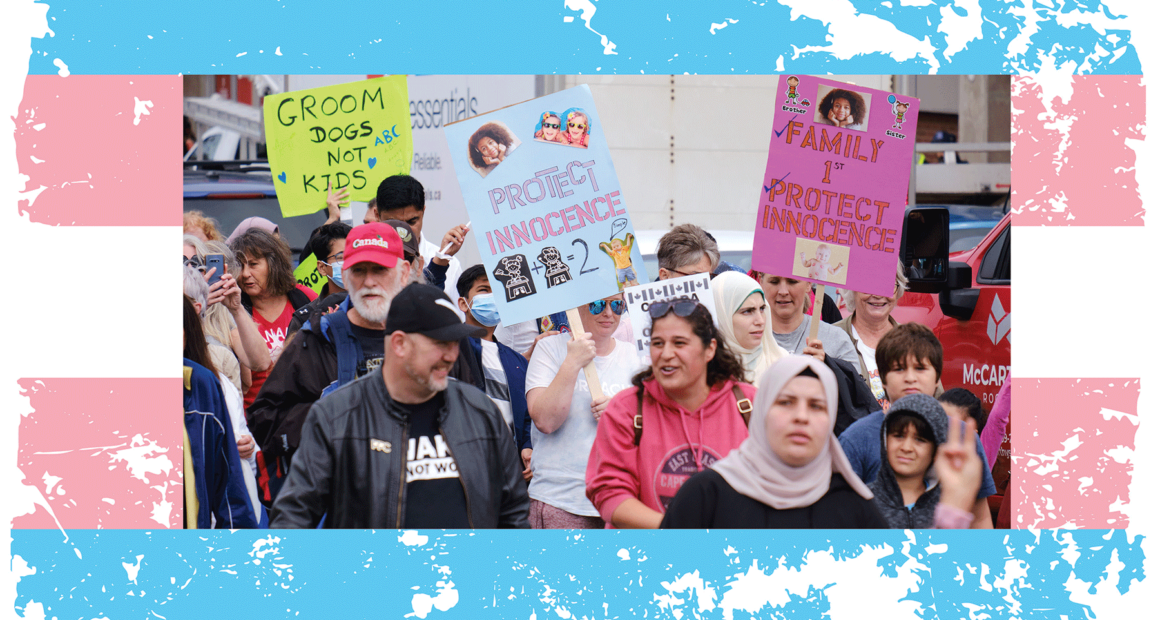Trans people need better news coverage. The solution begins with trans journalists

On a rainy evening in November 2024, the Black Sheep pub in Toronto’s Liberty Village was alive with a warm energy. The space buzzed with laughter and chatter as guests showed up to attend the launch party for the sixteenth issue of Queer Toronto Literary Magazine (QT). The issue, “Dream State,” was dedicated to celebrating trans and non-binary voices. Throughout the night, queer folks gathered, sipping their drinks, mingling, and thumbing through the magazine. Performers soon took to the pub’s stage—comedians, burlesque dancers, drag kings, visual artists, and poets all entertained the audience, who cheered enthusiastically.
Amir Patros, a trans multimedia artist, presented his piece, “Prince Zorah’s Disguise,” at the event. The ink and pencil crayon drawing shows a chapter in the story of Patros’s fantastical alter ego, Prince Zorah. Rich with bright rainbow hues, it depicts Prince Zorah in his bedroom, changing out of his regal disguise. The image was inspired by Patros’s desire to fulfill his childhood dreams of feeling like a prince. He describes sharing his art at this event as sweet and welcoming.
To Patros, QT’s “Dream State” issue stands in contrast to traditional news media since most trans and non-binary stories are covered in the context of laws introduced to restrict trans rights. “I don’t often see the media trying to uplift or highlight us in a good light. Publications like QT do change this.” The difference, he says, is that QT centres on the first-hand experiences of queer and trans people. The writing is not just about them—it’s by and for them.
QT was dreamt up in 2020 with this ethos in mind. The magazine’s editor, Pax Santos, noticed a lack of Canadian magazines dedicated to covering queer communities and trans stories. She wanted to fill this gap by creating a magazine by and for queer people. Five years later, the magazine is popular among Toronto’s queer communities, publishing art, journalism, and creative writing, both online and in print. Over the years, it has covered a range of topics, such as sex work, dating, queer liberation, mental health, as well as protest and resistance at Pride.
The 2SLGBTQIA+ volunteer team who runs the magazine dedicated their latest issue to trans and non-binary writing to address the same gap in coverage Patros identified: there aren’t enough stories about trans joy. “In the current state of the world, trans joy is a political necessity,” says Santos. While she is not trans herself, she cares about uplifting all members of 2SLGBTQIA+ communities. “As a queer community, we have an obligation to platform the insights that trans people make and share.”
In traditional newsrooms, trans journalists often struggle to secure staff positions, editorial power, or job security. Trans stories, especially, are rarely told, and when they are, it’s often by cisgender journalists. This coverage can be alarmist, lack accuracy, and perpetuate transphobic narratives. The upshot is incomplete coverage of trans people across the country—which can harm the queer communities being covered.
A Growing Moral Panic
In recent years, some of the most problematic coverage of trans issues has revolved around trans youth and their access to gender-affirming care. This coverage began to grow in the years before and during the start of the pandemic. In 2018, American journalist Jesse Singal produced a 9,000-word feature for The Atlantic that fanned the flames about youth who had decided to detransition—the subject had come out as trans, but later returned to identifying with their assigned gender at birth.
Yet detransitioning is exceedingly rare. In fact, a 2024 study in the peer-reviewed journal JAMA Surgery found that less than one percent of transgender people regret gender-affirming surgeries, and detransitioning may actually be on a decline. Singal, however, presented the issue as a growing concern. He focused his story on youth who regretted transitioning, inciting panic about children being “rushed” into choices they might later feel remorse over. The piece failed to quote even one happy, well-adjusted trans teenager.
The article went viral and was swiftly criticized by trans advocates, readers, and journalists, as well as their allies. Critics say Singal hyper-focused on rare cases and failed to capture the nuanced reasons a person might choose to detransition, such as familial pressure, lack of access to medical care, and societal discrimination.
While The Atlantic published rebuttals, the damage was done. It wasn’t the only publication to hop on the trend. Over the next several years, stories with a similar fixation on regretful transitions appeared in dozens of publications, including Reuters, The New York Times, Sky News, and BBC. Social media networks fueled the fire, harbouring right-wing conspiracy theories and hate speech in the comments of web publications like The Daily Wire (featuring Canadian pundit Jordan Peterson), and on X-based tabloid accounts like Libs of TikTok. The panic around trans youth and access to gender-affirming care intensified.
Canadian legacy outlets have done their fair share of this coverage. In 2021, for example, CTV published the investigative article, “Dramatic Increase in Children and Youth Seeking Gender Treatments Has Some Experts Alarmed.” The story suggested a youth’s desire to transition could be caused by previous trauma or mental illness, thus drawing on harmful stereotypes. Critics say this coverage treats trans identities in children as a problem that needs to be solved.
CTV is not the only one producing this harmful coverage. Publications such as the National Post are notorious for publishing transphobic op-eds in support of the so-called “parental rights movement,” a socially-conservative political movement that seeks to restrict 2SLGBTQIA+-positive policies and curricula in schools. This movement is linked to anti-SOGI (sexual orientation and gender identity) and anti-trans protests across Canada, including the annual 1 Million March 4 Children. The supportive coverage of these movements and protests was a letdown to Canada’s queer and trans communities—rather than accurately portraying these opinions as anti-trans hate, many journalists presented participants as concerned parents engaging in debate.
More recently, in February 2024, Radio-Canada aired the French-language documentary, Trans Express. Its title implies young people are transitioning due to social pressure and are rushed into receiving gender-affirming care. Amid its coverage of trans youth in Quebec, the documentary claimed, erroneously, that teenage mental illness can be linked to puberty blockers—medications that delay the onset of estrogen and testosterone—when, in reality, gender-affirming care is proven to improve the mental health of those who need them.
Trans Express over-represents the experiences of those detransitioning while failing to acknowledge the positive changes transitioning brings to most trans people. The first 40 minutes of the film only highlight the experiences of people who regret transitioning. It isn’t until the final three minutes that someone is shown to be happy with their transition, further insinuating that detransitioning is more widespread than it is.
The visual effects in Trans Express are manipulative. For example, a sequence of over-dramatized, shadowy, slow-motion scenes of a teenager injecting puberty blockers in the bathroom. Following a series of interview clips and statistics, the teenager is seen again, this time in a bathtub, seemingly depressed. These aesthetic choices make the subject of the documentary feel dark, almost sinister.
The documentary received backlash on social media and garnered 60 formal complaints against Radio-Canada. The organization’s ombud responded, claiming the documentary meets Radio-Canada’s journalistic standards. On Instagram, trans activist Celeste Trianon commented on the documentary, emphasizing the importance of journalists reporting on medical issues accurately. “When anti-trans groups are platformed by mainstream media, they gain legitimacy despite their use of junk ‘science,’” she wrote. “This is how anti-trans disinformation spreads. This is how you can induce a moral panic.”
This coverage exists against a backdrop of growing hate toward queer and trans communities. In 2023, Statistics Canada reported that hate crimes targeting sexual orientation rose by 69 percent—and according to the Human Rights Campaign, more than one-fifth of reported hate crimes in the United States in the same year were based on anti-2SLGBTQIA+ hate. Last year, the Canadian Security Intelligence Service warned that the “anti-gender movement” posed a threat of “extreme violence” to queer and trans communities. It also affects governing policies.
The United States has seen an onslaught of anti-queer and trans bills introduced in state legislatures several years in a row—in 2024, 50 were passed. These laws often face legal battles, and in several instances, anti-trans coverage is cited in defence of discriminatory laws.
Canada’s conservative politicians have begun to target trans rights, too. Between 2023 and 2024, provincial governments in New Brunswick, Alberta, and Saskatchewan proposed legislation and policy changes restricting the rights of trans youth. In the spring of 2023, New Brunswick premier Blaine Higgs temporarily rolled back a policy requiring schools to use students’ chosen names and pronouns. As a result, students under 16 could not use chosen names or pronouns at school without their parent or guardian’s consent. (The original policy protecting kids’ self-identification rights was reinstated last year).
In October 2023, Saskatchewan introduced its “Parents’ Bill of Rights,” which also forces schools to seek parental consent before adhering to the chosen names and pronouns of students under 16. Then, last year, Alberta introduced Canada’s most restrictive anti-trans law—the Health Statutes Amendment Act. On top of including the same parental notification laws as Saskatchewan, the act also bans doctors from providing children under 16 with gender-affirming care, such as puberty blockers or gender-affirming hormones. (Sixteen- and 17-year-old children can access gender-affirming care only with parental consent). The Fairness and Safety in Sport Act, introduced at the same time, bans transgender athletes from competing on sports teams that are not co-ed.
These anti-trans policies and their ideology are supported by politicians such as Conservative Party of Canada leader Pierre Poilievre, who was quoted in multiple press conferences last year saying he is in favour of bans on puberty blockers and on trans women in sports. More recently, when asked about Canadians’ gender expression, Poilievre told journalists he believes the government should mind “its own damn business.” But in the same breath, he said he is not aware of more than two genders, implying the legal recognition of non-binary Canadians could be at risk. As Canada nears a federal election, there will be increased discussions about trans issues among politicians, making representative and factual coverage vital to protecting queer and trans communities.
Why Can’t Canadian Media Get It Right?
Journalist and queer media instructor Andrea Houston believes that poor coverage of trans issues is a symptom of Canada’s ongoing media crisis. A lack of funding for Canadian newsrooms, she says, has resulted in layoffs of many media workers. “We’ve seen that the journalists that are the first to be cut are the queer and trans BIPOC journalists because they’re often the most recently hired,” she says, “and they’re the people who are pitching intersectional stories.” When newsrooms lack trans and non-binary voices, stories about their communities do not get pitched as often—and when they do, they are not always told responsibly.
Mel Woods, a senior editor at Xtra magazine, says many well-meaning journalists fail to adequately cover trans issues due to, in part, poor sourcing and lack of research. In many cases, journalists who don’t intentionally immerse themselves in trans communities hold less nuanced and informed understandings of the issues they face. On the other hand, journalists may avoid covering trans stories for fear of getting things wrong. As one of Canada’s most visible trans journalists, Woods often feels as though they are one of few people reporting on trans issues. “I’m often asked to speak on behalf of all trans people,” they say. “I’m not qualified to do that.” Woods hopes to see more job opportunities for trans journalists in the future through more equitable hiring practices. This will help with “bringing that multiplicity of perspective,” Woods says. “Multiple kinds of trans people from different backgrounds.”
Nuanced, accurate reporting on trans and non-binary issues is only going to grow more crucial as anti-trans hate rises
Despite these setbacks, reporting on trans issues has improved vastly in comparison to coverage from recent decades. Discussions of gender-affirming care and trans rights in the public sphere have gradually become more common since the 1970s but were rarely mentioned on the news until the late 1990s. Back then, the stories of trans people were often misunderstood. Outside of independent, underground 2SLGBTQIA+-led print media, few trans people had the opportunity to produce their own stories.
Until the 2010s, news outlets rarely produced supportive coverage about the fight for trans rights. Journalists were more likely to produce shock content perpetuating common stereotypes and hateful slurs than they were to cover trans issues with compassion or care. The past 15 years have shown improvements in reporting on trans issues, and newsrooms began including a greater number of trans writers, editors, and sources.
While hiring more trans journalists does help improve coverage, cisgender journalists also need to develop their skills to cover trans communities. Many resources exist to help journalists get things right. The international Trans Journalists Association, co-founded by American journalist Kae Petrin in 2020, created one of the most commonly used trans style guides. The guide covers a variety of topics, such as best practices for covering trans-centred healthcare and legislation, how to use pronouns and chosen names correctly, and politicized or inaccurate phrases to avoid. This style guide has “become a tool that a lot of newsrooms have used to make sure that their coverage is a little more accurate,” says Petrin, as it answers questions about common issues that journalists may not be familiar with or are encountering for the first time.
The 519, a 2SLGBTQIA+ community centre in Toronto, Ontario, also created a style guide for reporting on queer and trans issues in 2022. Their version focuses on topics such as respectful language while interviewing, pronoun usage, and how to appropriately address non-binary and two-spirit people.
Style guides can discourage media outlets from shying away from reporting on trans issues as they create a foundation for journalistic best practices. They are vital to ensuring trans people are treated respectfully in the media, while also influencing readers to follow the same guidelines of respect when interacting with trans people.
Hope for the Future
After the QT launch last December, Santos still thinks about the importance of journalists and media workers covering trans stories. Nuanced, accurate reporting on trans and non-binary issues is only going to grow more crucial, she says, as anti-trans hate continues to rise. “I feel very privileged to be able to create a space that is specifically for showcasing what trans and non-binary people create,” Santos says about the impact of “Dream State.”
Comprehensive reporting of trans stories is about more than just inclusion and representation—it is about solidarity and a fight against rising hate. Santos hopes to see more writers join that fight. “We are in a distinct political moment,” she says, “when the global anti-gender movement is identifying trans and non-binary people as an existential threat.”
Santos believes that trans communities are canaries in the coal mine for other queer communities, meaning they will be the first to feel the impact of rising anti-queer hate. “As someone who is not trans, I feel strongly in my obligation to take up arms with my siblings.”
About the author
Quinnlyn is a fourth-year undergraduate journalism student. They have fact-checked for The Otter and are a copy editor for HUES magazine with a passion for reporting on arts and culture as well as social justice issues. When they’re not writing or editing you can find them spending time in nature or silversmithing.



